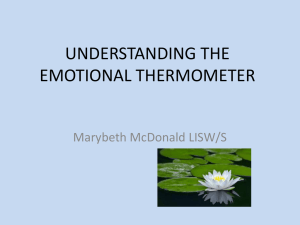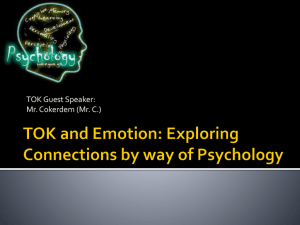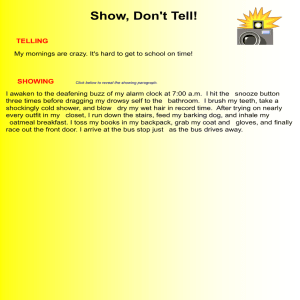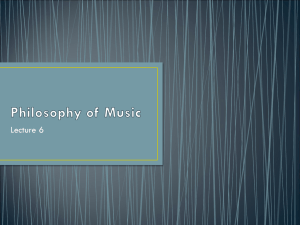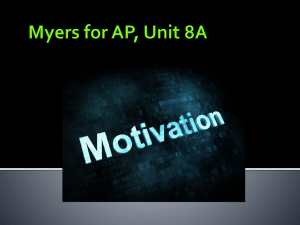Parenting and Self-Regulation - Offord Centre for Child Studies
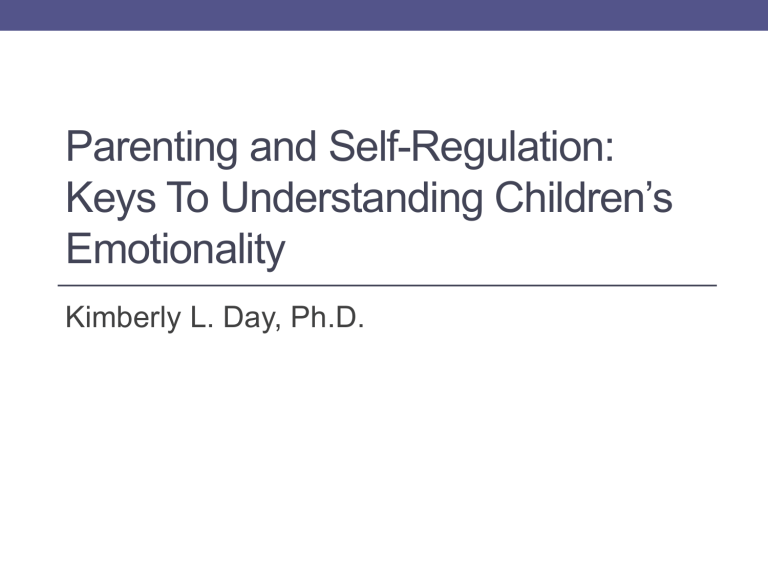
Parenting and Self-Regulation:
Keys To Understanding Children’s
Emotionality
Kimberly L. Day, Ph.D.
Importance of Self-Regulation
• Includes motivational, cognitive, affective, and behavioral components
• Two types of self-regulation
• Emotion regulation
• Private speech
Emotion Regulation
• Strategies and emotionality
• Distraction and self-comforting
• Conflicting findings
• Shift from external to internal regulation cuddlebugs.onslow.org
Private Speech
• More common in cognitively-taxing tasks
• Improved cognitive abilities
• Aid in task completion
• Encourage in classrooms www.hlntv.com
Negative Emotionality
• At risk for negative outcomes
• Externalizing behaviors
• Poorer social skills
• Lower peer status www.piz18.com
blog.southeastpsych.com
Theoretical Basis
• Bandura’s Social Learning Theory
• Modelling
• Reinforcement
• Observational learning
• Vygotsky’s Sociocultural Theory
• Developmental level
• Scaffolding
• Private speech
• Internalization
Overview
• Studies
1.
2.
3.
Relation of private speech to emotion regulation and emotionality
Parenting related to children’s private speech
Selfregulation predicting parenting and children’s emotionality
• Future directions
STUDY 1
Private Speech and Emotion Regulation
Private Speech and Emotion Regulation
• Private speech – Speech directed to the self
• Typically investigated during cognitive tasks
• Language
• One of the most important cognitive components of emotion regulation
• Gives children the ability to describe their feelings
• Therefore, children’s private speech should be related to their emotion regulation
Research Questions
1.
Does children’s private speech predict children’s negative emotionality above and beyond children’s emotion regulation strategies?
• Hypothesis 1: C hildren’s private speech would be a unique predictor of their negative emotionality above and beyond their regulation strategies.
• Hypothesis 2: Children who used more beneficial private speech were expected to display less anger and sadness.
• Hypothesis 3: Children who used more non-beneficial private speech and social speech were expected to display more anger and sadness.
Research Questions
2.
Does children’s private speech moderate the association between children’s emotion regulation strategies and their negative emotionality?
• Hypothesis: Expected that children with more beneficial private speech and more emotion regulation strategies would have less negative emotion.
Sample
• 116 preschoolers
• 4.5 to 6 years old
• 62 boys, 54 girls
• Predominately white, middle-class
Locked Box Task
Measures
Distraction Self-Comforting
Measures
Anger Sadness
Measures
• Beneficial private speech
• Inaudible muttering (27%)
• Facilitative task-relevant (86%)
“First I’m gonna start off with this one.
”
“This must be the key.”
“Does that fit?”
“I get to play with the toys after I find the key.”
Measures
• Non-beneficial private speech
• Vocalizations (98%)
• “Uhh,” “Bo do do,” Ohumph”
• Task-irrelevant (3%)
• “We need to get to the bowling alley”
• Negatively valenced task-relevant (48%)
• “I can’t do this,” “I’m never going to get this,” “I can’t get it”
Measures
• Social speech (95%)
“Mommy, how do you work it, I don’t know.”
“Mommy, can you help me put it in?”
“Will somebody help me?”
RESULTS
Regression Analyses Predicting Anger from
Regulation Strategies and Speech
1. Age
2. Distraction
Self-Comforting
3. Social speech
Vocalizations
Inaudible muttering
Negatively valenced task-relevant
Facilitative task-relevant
4. Negatively valenced x Distraction
F for model
β
-.09
-.38**
-.11
.13
.30**
-.04
.25*
-.19*
.18*
6.29**
Anger
R 2
.00
.20
.32
.35
∆ R 2
.00
.20**
.12*
.03*
* p < .05, ** p ≤ .001
1,2
1,1
1
0,9
0,8
0,7
0,6
Relation of Distraction to Child Anger at Three
Levels of Negatively Valenced Task-Relevant
Private Speech
1,3
Negatively Valenced
Task-Relevant Low*
Negatively Valenced
Task-Relevant Moderate*
Negatively Valenced
Task-Relevant High
Low Moderate
Distraction
High
*p < .01
Regression Analyses Predicting Sadness from Regulation Strategies and Speech
1. Age
2. Distraction
Self-Comforting
3. Social speech
Vocalizations
Inaudible muttering
Negatively valenced task-relevant
Facilitative task-relevant
4. Vocalizations x Self-Comforting
F for model
β
.23*
.03
.15
.25*
.16
-.10
.29*
-.16
-.22*
3.57**
Sadness
R 2
.04
.05
.19
.23
∆ R 2
.04*
.01
.14*
.04*
* p < .05, ** p ≤ .001
0,8
0,7
0,6
0,5
0,4
0,3
Relation of Distraction to Child Sadness at Three
Levels of Vocalizations
0,9
Vocalizations Low*
Vocalizations Moderate
Vocalizations High
Low Moderate
Self-Comforting
High
*p < .05
Conclusions from Study 1
• Private speech occurred during an emotioneliciting task
• Private speech predicted negative emotions above and beyond emotion regulation strategies
• Implications for caregivers and educators:
• Cognitive tasks can be frustrating
• Private speech should be encouraged because it aids cognitive and emotional self-regulation
• Can re-direct children when they are using less beneficial private speech
STUDY 2
Parenting and Private Speech
Parenting and Private Speech
• Limited research on how parenting behaviors relate to children’s private speech
• Importance of parenting for children learning to self-regulate
• Need to incorporate positive and negative parenting behaviors
Research Question
1.
How do maternal behaviors in toddlerhood predict children’s beneficial private speech in preschool?
• Hypothesis: Maternal supportive and directive behaviors would interact to predict children’s beneficial private speech.
Sample
• Longitudinal mother-child study
• Toddlerhood (T1) Visit
• 140 toddlers
• 30 to 36 months old
• 88 boys, 52 girls
• Preschool (T2) Visit
• 116 preschoolers
• 4.5 to 6 years old
• 62 boys, 54 girls
Measures: Toddlerhood Visit
• Free play sessions
• Supportive behavior
• Sensitivity
• Involvement
• Directiveness
Measures: Preschool Visit
• Locked box task
• Beneficial private speech
• Inaudible muttering
• Facilitative task-relevant
RESULTS
Regression Analysis Predicting
Preschoolers’ Beneficial Private Speech from Maternal Behaviors in Toddlerhood
1. Age
2. T1 Maternal directiveness
T1 Maternal suppportiveness
3. T1 Maternal directiveness x supportiveness
F for model
T2 Beneficial Private Speech
β R 2 ∆ R 2
.19*
-.15
.00
.05
.06
.05*
.01
.10
.04* -.22*
3.21*
* p < .05
Relation of Directiveness to Beneficial Private
Speech at Three Levels of Support
12
11
10
9
8
5
4
7
6
Support Low
Support Moderate
Support High*
Low Moderate
Directiveness
High
*p < .05
Conclusions from Study 2
• Maternal behavior in toddlerhood predicted preschoolers’ later self-regulation
• Important to take both sensitive and directive parenting into consideration
• Implications for caregivers and educators:
• Being overly involved can inhibit children’s future regulatory skills
• Need to scaffold children’s regulatory abilities
• Balance of moderate supportive and directive behaviors may be best
STUDY 3
Putting It All Together
Putting It All Together
Parent
Emotion
Coaching
–
+
Children’s
Effortful
Control
EC x PS
–
Children’s
Non-Beneficial
Private Speech
+
Children’s
Negative
Emotionality
Effortful Control
• Purposeful ability to start, stop, and modulate attention and behavior
• Believed to play a central role in children’s regulation of their emotional expression
Emotion Coaching
• Includes cognitive and emotional components
• How parents think and talk about emotion
• Teach emotion knowledge
• Importance of negative emotions
Putting It All Together
Parent
Emotion
Coaching
–
+
Children’s
Effortful
Control
EC x PS
–
Children’s
Non-Beneficial
Private Speech
+
Children’s
Negative
Emotionality
Sample
• 156 parent-child dyads
• 3 to 5 years of age
• 79 boys, 77 girls
• Primary caregiver
• Mother 91% ( n = 142)
• Father 6% ( n = 10)
• Other 3% ( n = 4)
• Predominately white, middle class
Measures
• Parental emotion coaching during an emotion talk task
• Encouragement of negative emotions during an upset event
• Labeling
• Validating
• Causes and consequences
Measures
• Private speech
• Selective attention task
Measures
• Non-beneficial private speech during the selective attention task (59%)
• Vocalizations
• Task-irrelevant
• Negatively valenced task-relevant
Measures
• Parent-report on Child Behavior Questionnaire
• Emotion regulation
• Effortful control
• Negative emotionality
• Anger
• Sadness
RESULTS
Parental
Emotion
Coaching
.24**
.00
Child
Sex
.17*
Children’s
Effortful
Control -.39**
.04
Children’s
Negative
Emotionality EC x PS .15*
Children’s
Non-Beneficial
Private Speech
-.19*
Child
Age
.20**
.20**
Child
Age
* p < .01, ** p < .05. SRMR = .02, CFI = 1.00.
Relation of Effortful Control on Negative Emotionality at
Three Levels of Non-Beneficial Private Speech
4
3,5
3
2,5
2
1,5
Non-Beneficial Low*
Non-Beneficial Moderate*
Non-Beneficial High*
Low Moderate High
Children's Effortful Control *p < .01
Conclusions from Study 3
• Effortful control mediated the relation of parental emotion coaching to negative emotionality
• Significance of non-beneficial private speech
• Replicated finding that children’s private speech moderates the relations of emotion regulation to negative emotion
• Implications for caregivers and educators:
• Cognitive and emotional abilities work together
• Important to support children’s negative emotions
• Assist children using non-beneficial forms of private speech
FUTURE DIRECTIONS
Paper #1
• Extremely low birth weight (ELBW)
• Normal birth weight control sample
• Literature review
• Bullying and ELBW children
Paper #2
• Characteristics of ELBW victims
• Functional limitations
• Anxiety and ADHD
• Motor skills
• Self-esteem
• School and peer connectedness
Paper #3 – Part 1
Only with ELBW survivors:
Bullied vs.
Not bullied
Protective factors:
Family, friends, school relations
Outcomes:
Internalizing, externalizing
Paper #3 – Part 2
Only with victims of bullying (ELBW and NBW):
ELBW vs.
NBW
Protective factors:
Family, friends, school relations
Outcomes:
Internalizing, externalizing
Paper #4
Experience of bullying
Outcomes:
Wealth, health, social status


